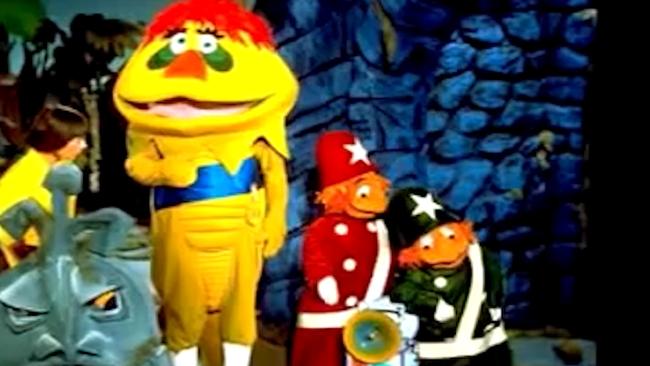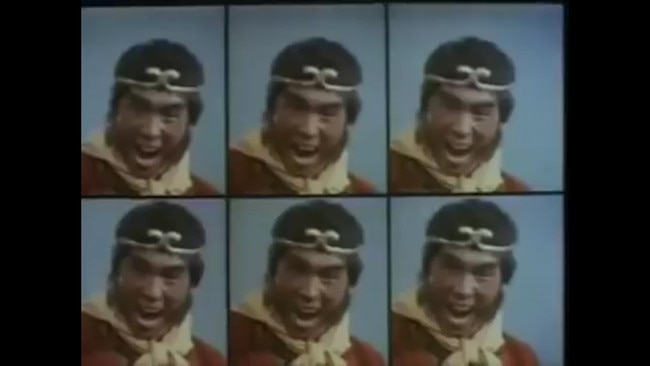The weird and wonderful ‘70s and ‘80s TV shows our kids need to see
The plots were zany, the costumes tacky and for some reason they featured a lot of puppets. They are the classic kids TV shows that kept us captivated for hours in the 1970s and 1980s. But what would our kids make of them today?

Lifestyle
Don't miss out on the headlines from Lifestyle. Followed categories will be added to My News.
Thank goodness it’s not the 1980s.
Back then, we had only five TV channels in the capitals, and only three in the country.
We could make much better use of all these free-to-air digital TV channels these days if we brought back these 10 classic kids’ TV shows.
Most of them make no sense today, but somehow kept us captivated for hours in the 1970s and 1980s.
The networks should bring them back and let us test drive them on the kids while the weather’s cold and there’s not much to do.

MONKEY
When a 16th century Chinese book becomes a modern-day Japanese children’s TV series, it’s bound to get weird.
And Monkey was so weird, it worked.
Its Japanese title was Saiyuki, which translates to Account of the Journey to the West, and it was filmed in northern China and Inner Mongolia between 1978 and 1980.
It’s a long story, but Heaven outcasts Monkey, Sandy, and Pigsy, with Buddhist monk Tripitaka, were heading from China to India to collect some holy scriptures, and faced plenty of shenanigans in human and supernatural form on the way.
Monkey has aired many times on the ABC and has developed a cult following. Would it catch on with kids today?
THE CURIOSITY SHOW
This gem began as a science segment in Here’s Humphrey in 1971, but was spun out into a series focused on science and nature for the Nine Network in 1972.
The program had a series of presenters until it switched from 60 minutes to 30 minutes in 1980, but Dean Hutton and Rob Morrison were always the program’s mainstays from 1972 until 1990.
The beauty of The Curiosity Show was the daggy earnestness of Deane’s and Morrison’s delivery as they conducted experiments, always with a warning to get your parents’ permission before trying one at home. It was such unfashionable, nerdy fun.
Hard core fans can drop by The Curiosity Show YouTube channel for gems like these.
Here, Morrison shows us how fireworks get their colours.
And Hutton gives us a window on an optical illusion we can replicate at home.
H.R. PUFNSTUF
This positively freaky children’s series debuted in the United States in late 1969 and aired on the Nine Network in the 1970s.
For a show that only had 17 episodes, and a single feature film, H.R. Pufnstuf is ingrained in the memories of children of the ‘70s all over the world.
An English boy named Jimmy, played by Jack Wild, who owns a magic talking golden flute called Jimmy that lives in his shirt pocket, is lured to Living Island by the evil Witchiepoo (Billie Hayes) on a boat she controls so she can grab Freddy for herself.
But once he arrives on Living Island, Jimmy is protected by the local mayor, a kindly dragon named H.R. Pufnstuf, who introduced him to a kaleidoscope of life-size puppet and costumed characters.
Everything on the island is alive and often voiced by impersonations of famous stars.
Brothers Sid and Marty Krofft produced this luridly colourful show, which is bound to warp the minds of youngsters today just like it did when we watched the original on Nine back then.
SHIRL’S NEIGHBOURHOOD
What happens when the lead singer of one of Australia’s biggest bands leaves the group to briefly go solo, only to become a children’s show host on local television? Magic, that’s what.
Shirley Strachan left Skyhooks in 1977 and went solo before landing in Shirl’s Neighbourhood on Seven with co-host Liz Rule and a cast of puppet characters in 1979 including Norm the Kangaroo (complete with North Melbourne scarf, acerbic Claude the Crow and his used Band Aid collection), Stanley the Snake, Greenfinger the Garden gnome and Ol’ Possum.
They appeared between filmed segments in this magazine-style show, which lasted until 1983.
THE TOMORROW PEOPLE
This English sci-fi program, produced by ITV between 1973 and 1979, focused on a group of young people who were the first of a new evolutionary group of humans known as Homo superior, each with extraordinary powers.
They were sheltered during their teenage evolutionary metamorphosis in The Lab, an abandoned London tube station, which was controlled by a computer with biological features and artificial intelligence known as TIM, which was built by the Tomorrow People leader, teenage scientist John.
It was a bit dark for its time and a worthy rival to the BBC’s Doctor Who.
It aired on Seven here, and more recent remakes might suggest the original ‘70s version is worth another run today.
THE GOODIES
This anarchic trio was an afternoon staple for kids everywhere on the ABC in the ‘80s, long after The Goodies’ 1970s prime.
Bill Oddie, Graeme Garde and Tim Brooke-Taylor got into all kinds of mischief with a work ethic that they’d do “anything, any time” and generous helpings of absurdist humour and slapstick.
There were 77 episodes made between 1970 and 1982, but it was repeated constantly on the ABC and has captivated generations of young fans.
MORE NEWS:
WHY HOLDEN SHOULD HAVE DUMPED ITS ICONIC NAME
WHEN MILK BARS RULED MELBOURNE’S SUBURBS
SUPERGRAN
Another ABC after school favourite for the UK, Supergran is the story of Granny Smith, a Scottish woman in her 80s who gets zapped by Inventor Black’s ray machine and develops amazing super powers that give her the ability to belt the snot out of all the villains in her home town.
PUGWALL
The adventures of 13-year-old Peter Unwin George Wall and his attempts to negotiate life while trying to become as guitar hero in a rock band was a highlight on Nine for kids in the late ‘80s.
And it was a very ‘80s story featuring clueless parents (Pugwall’s dad “Herohead” was played by Ken James) and many unlikely, off-the-wall adventures.
Pugwall, played by Jason Torrens, gets an electric guitar for his 13th birthday and forms a band with no singer, the Orange Organics, with mates Stringbean, Bazza and Orfo. Pugwall stacks his bike while daydreaming about stardom and winds up in hospital, where he meets Jenny and gets her to sing.
Pugwall and the Pugwall’s Summer sequel were popular enough for two albums featuring music from the show despite some … er … clear musical shortcomings. Here’s the Orange Organics in action, playing the series’ theme tune.
SWEET AND SOUR
So much hair product. So much pastel. But that, apparently, was the music scene in 1984, when Sweet and Sour first aired on the ABC.
Sweet and Sour was the story of a fictitious band, The Takeaways, from their formation to the release of their independent single (the title track, Sweet and Sour), meeting industry figures along the way like Molly Meldrum and Jon English.
The series starred Tracy Mann as singer Carol and David Reyne as lead guitarist Martin. Reyne won a Logie for his performance.
It was more serious musically than Pugwall. Well-known Australasian musicians loaned their talents to the show’s two soundtrack albums including Sharon O’Neill, Dragon’s Todd Hunter, Reg Mombassa from the Mentals, Don Walker and Ian Moss from Cold Chisel, Rick Grossman from the Hoodoo Gurus, David McComb from The Triffids and Chris Bailey from The Angels.
Deborah Conway, Carol’s singing voice, soon struck success with Do Re Mi and as a soloist.
The Sweet and Sour single, written by O’Neill, hit number 13 on the Australian charts.
ADVENTURE ISLAND
This wonderful pantomime-style program aired weekdays on the ABC from 1967 to 1972, and was written largely by actor John-Michael Howson, who also starred as Clown in the series.
Two hosts, Nancy Cato until 1968 and Sue Donovan from 1969 on, introduced a new story set in the town of Diddley-Dum-Diddley on Adventure Island, and each was a tale of good triumphing over evil.
In fact, young viewers were often reminded through a week’s storyline that “it always turns out all right on Fridays” as the characters battled the “baddies”.
Adventure Island was controversially axed in 1972. A groundswell of public protests failed to save it.
